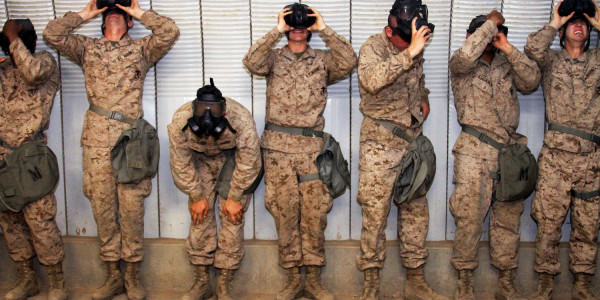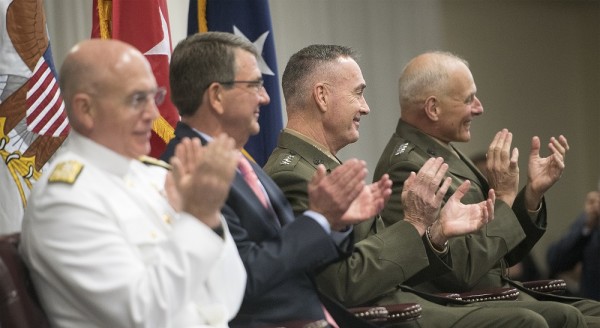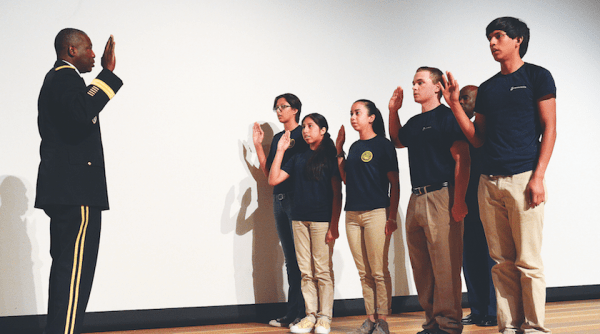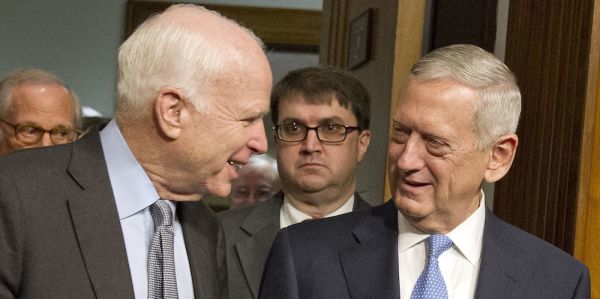Editor’s Note: This article is part one of a two-part article responding to “Can the U.S. Military Halt Its Brain Drain?” — an essay published in The Atlantic by David Barno and Nora Bensahel on Nov. 5, 2015.
David Barno and Nora Bensahel are concerned about a “brain drain.” They worry that “he military services today are losing talent.” They acknowledge that “he military must always shed leaders,” but they point out that “it is essential to shed the right people—and not to lose too many of those with the brightest prospects or the most innovative minds.” Our junior officers are almost all part of the millennial generation. The challenge we face, as Barno and Bensahel outlined in a recent article in The Atlantic, is to find ways to get “the best of this group of junior officers to decide to remain in uniform for a career …”
Framing the problem
How we identify and describe a problem influences how we go about looking for solutions. Barno and Bensahel highlight the need to retain our best talent and they identify a problem standing in the way of that goal. The problem, according to Barno and Bensahel, is that our “rigid and anachronistic personnel system is driving too many bright, innovative, and creative officers out of the military.” The authors argue that the job-related attributes valued by millennials are poorly catered to by our personnel system. As a result, these millennials are choosing to leave the military for civilian careers where there is a perception of greater control over one’s career and greater opportunity for fulfilling career paths.
To argue that our personnel system needs reform is to state the obvious. It will always need reform, even after the next set of reforms, whatever they might be. There is no single ideal personnel system, because the needs of the services will continuously change. Society and demographics continuously change. Because our personnel system’s two most salient stakeholders are always changing and always in competition, the system must continuously evolve to simply be adequate.
How should our personnel system evolve? If one is persuaded by Barno and Bensahel, then our system should prioritize graduate school educational opportunities for officers, somehow find a way for dual military officers to find career-enhancing jobs without excessive separation from spouses, do a better job of matching skill sets to duty positions, and be more accommodating to officers who wish to have children and a stable home life. Those are all laudable goals. Some should be priorities, but some should not, and some already are.
What millennials want
The authors provide a profile of today’s junior officers by describing relevant characteristics of the millennial generation. They then infer that millennials who serve in uniform will likely share many of those characteristics. Millennials, according to the authors, value the following:
- Personal and family life above paychecks
- Diverse work experiences and the ability to change jobs often
- A bigger say in their career paths and their future
- Higher education
- Flexibility to leave jobs, companies, and career fields at a much higher rate than their predecessors
- Merit-driven upward mobility
- Dislike hierarchy, bureaucracy, and inflexibility in the workplace
This is a list of things that millennials want in a transactional relationship with their employers. It is not a list of values or attributes of an organization or culture that they wish to be a part of. Barno and Bensahel acknowledge that our junior officers have selfless aspirations, but the authors’ analysis focuses on selfish desires. This leads Barno and Bensahel down a rabbit hole of benefits and perks. Our junior officers — particularly those whom we want to keep — are better than this.
If you read that list of things that millennials want, then read the article, and then re-read the list, it is very perplexing. The authors criticize aspects of the military personnel system that provide what millennials want while simultaneously arguing that the personnel system is not providing what millennials want. When the personnel system emerges from this no-win analysis, the authors declare it is the personnel system, not their flawed analysis, that is in need of major reforms.
Barno and Bensahel assert that millennials value “diverse work experiences and the ability to change jobs often.” But much of the article criticizes the military services for requiring officers to take on diverse work experiences and to change jobs often. The authors lament that officers “typically change jobs every one to two years …” They lament that the personnel system ensures “as many officers as possible get through all the ‘gates’ needed to be eligible for command or promotion,” because “ultiple jobs and a diversity of locations … continue to be valued by promotion boards …” They lament that “constant job shifting also creates a military where every officer is expected to perform across multiple, often unrelated skill sets …”
Millennials “see themselves as likely to leave jobs, companies, and career fields at a much higher rate than their predecessors.” Yet, the authors warn us that our millennial junior officers “expect their lives to have a modicum of stability, protected from constant moves and job changes.” In this case, “a modicum” apparently means more than a couple years in one locale.
Barno and Bensahel lament that “military personnel are not permitted to stay in the same job or rank year after year—even if the position may be one for which they are perfectly suited, by skill or disposition.” This leads to “a military of incessant turbulence …” One would think then that the authors would be encouraged if someone whose skill or disposition were suited to human resources could actually remain in human resources. Instead, the authors criticize our personnel system as being influenced by “entrenched personnel bureaucrats” who “have served for decades …”
First-world problems
The authors intersperse their discussion with vignettes from the experiences of two officers, one in the Army and one in the Marine Corps. These two do not inspire sympathy, and do not illustrate a personnel system failing to accommodate the transactional desires of millennials. Both individuals went to service academies. They paid no tuition, had free room and board, were paid a monthly stipend, and graduated with degrees that are viewed very favorably by any admissions committee.
The Army officer was apparently permitted to attend graduate school in London, rather than promptly going to work for the Army. Some relevant issues not discussed by Barno and Bensahel include whether that officer studied while on an educational delay (permitting him to delay beginning his obligated service to the Army until after graduation) or if he received salary or allowances while in London; whether that year was creditable to time in service for pay or retirement purposes; and whether he incurred an additional active-duty service obligation. These are significant considerations in the cost-benefit analysis for the officer and the military.
After attending graduate school in London, the officer was fortunate to secure a year-long deployment to Afghanistan early in his career. Only four months after his return, he secured another great deployment as an aide to a Navy admiral “working strategic-level policy issues” in Afghanistan. Thus far, this sounds like one of the most well-treated officers in the Army. As deployments dry up, people are fighting for the opportunity to simply deploy once. Fewer still get the opportunity to just take a year off from work to go to graduate school. The Army officer’s follow-on deployment exposed him to interesting and novel issues, and enabled him to further develop professionally and to make contacts with senior personnel who could provide him with valuable mentorship and advice.
Missing from the analysis
While weaving the Army officer’s tale of woe, Barno and Bensahel make no mention of whether he was the best qualified. They do not speculate on the qualifications of the individuals whom he was competing against for his jobs of choice. They do paraphrase him as saying that he “sees himself as no more talented or skilled than a wide range of his peers.” Perhaps he is being humble. We are taught after all to deflect praise to our peers and subordinates. But Barno and Bensahel blame the personnel system with no mention of what type of competition he was up against. They do mention that the officer “interviewed” for a job, but this is not the merit-driven process that many civilians would envision. For a junior officer to be given the opportunity to interview for a position is a largely foreign concept to those who do not have contacts among the general officer and flag officer ranks, or those unable to leverage an alumni network at their service academy. Junior officers are the equivalent of new associates in a corporation and their early development prior to company, battery, or troop command is purposely mapped out uniformly within their specialty branches.
Another dynamic omitted from this discussion is that not everyone who leaves uniformed service stops serving the military. Take, for example, the Marine Corps officer’s husband. Her husband left the Marine Corps and is now a civilian working for the Department of the Army. Some officers leave and return to uniformed service. I left the Army as an infantry officer, paid my way through law school, then returned to the Army as a military attorney.
Most civilian employees with whom I have worked in the military are veterans. Their tacit understanding of the military, along with the institutional knowledge that they amass by being able to remain in their positions for long periods of time is incredibly valuable. This organization-specific institutional knowledge is complemented by the broader experience of uniformed personnel who bring in ideas from other units, other regions, and other theaters of operation.
The services sometimes “lose” personnel from the uniformed ranks, but they often continue to provide an immensely valuable service to our military. Our civilian personnel provide the continuity that our uniformed personnel cannot, and they facilitate institutional knowledge-building. Spend time at a combatant command, component command, or other major command headquarters, and you will quickly see that civilians, although they are not in command, have substantial influence over policy, strategy, and day-to-day operations.
Needs of the service
Barno and Bensahel advocate for the officer who wants to have it all: combat deployments, a stable family life, children, graduate education, duty positions of choice, and upward mobility. But that needs to be balanced with the needs of the service and the substantial burdens placed on the taxpayer to accommodate these servants.
Issues relating to stability, family life, and assignments, particularly for families where both spouses serve in the military, are complicated and interrelated. But the common stressor on each has been frequent deployments. As these deployments have wound down, those stressors are becoming less significant. If the reader thinks life was tough for the two officers profiled, ask around among those who served prior to 2010. Things have improved and continue to improve. Continuing on our current path is likely simpler, cheaper, and a better use of time and money than disrupting a personnel system that is going to naturally evolve after our drawdown in Iraq and continued drawdown in Afghanistan.
The simplest perk mentioned by the authors is that of graduate education. It sounds great. We all know education is important. But an officer in graduate school is not performing any duties for the military. Although this can be viewed as an investment in the individual’s human capital with anticipated future returns, we do not measure that return on investment. If we did, it is likely that the return is often negative. An officer in graduate school may receive any or all of the following: a large salary, hefty tax-free allowances, and time creditable for time in service (which raises his or her salary and moves him or her closer to retirement) and time in grade (moving him or her a year closer to promotion eligibility and a larger raise). The officer may obtain some additional, intangible, difficult-to-measure knowledge, skill, or ability. The officer may also incur an extension to his or her service obligation — the amount of time that he or she must remain in the military. Often, this is two-for-one, so for every month in school, the officer must serve two additional months. But if that officer remains until retirement eligibility, which is one of the stated goals of offering these educational enticements, he or she will nonetheless make it to 20 years of service having performed one or more of those years in school, at taxpayer expense, rather than leading troops or otherwise doing work for the military.
As stewards of taxpayer largesse, we need to be certain that we are sending people to graduate school for sound reasons that justify the investment. For the amount of money and for the number of hours of work lost, we should have some reasonable expectation that the officer is going to do something great after graduation. And this is also true of other perks and benefits mentioned by the authors. Before focusing on the needs of the individual, we need to focus on the needs of the service. That is, what does the service actually need? Yes, we need smart, adaptable people. But what specific skills and attributes do we need? It is not enough that an officer is smart. Lots of us are smart. Personnel management is more complicated than amassing a bench of smart people.
The authors provided indications of how the officers’ personal goals conflicted with personnel policies, but made no mention of what needs the military services presented that the officers were best suited to fill. This is a reality of any career, not just the military. You can have a great set of skills and experiences. But if your employer, or potential employer, does not need those skills or experiences, or if they find someone better suited, then you need to look elsewhere to have your individual needs met. That is not an indication of a broken personnel system. That is an indication of a personnel system functioning properly.
Five years ago, then-Secretary of Defense Robert Gates set up an independent board to examine spending in the Department of Defense. Generals and admirals were criticized due to the lavish perks and benefits that they enjoy. Barno and Bensahel are focused on junior officers. But the head of that independent board made a statement equally relevant to this discussion when he remarked that “General Motors did not set out to become a benefits agency that occasionally built a car… We don’t want the Department of Defense to become a benefits agency that occasionally kills a terrorist.”
Conclusion
The military services need to track who is leaving and determine how to measure their talent against their peers who remain, before we argue that we are suffering a brain drain. Sometimes talented people are outcompeted by people of greater talent.
The no-win analysis from Barno and Bensahel, where they identify requirements, and then lament implementation of those requirements, is an inadequate assessment on which to base calls for reform. We should demand a more comprehensive and evidence-based analysis before we make perks and benefits the main effort in our mission to retain talent.
A comprehensive analysis needs to consider alternative opportunities to serve in our civilian workforce, because those are viable options for service members who feel that uniformed service is incompatible with their life priorities.That analysis should also consider that issues concerning family life, stability, and predictability have improved over the last 10 years and continue to get better.
Most importantly, we need to consider what improvements can be achieved through other avenues, particularly changes in our organizational culture. The notion that organizational culture matters is neither new, nor novel. It is a complex issue, not well suited to easy answers. But sometimes we need to address a challenge by substituting intellectual heavy-lifting in place of our standard response of throwing money at it. This is one of those times.








